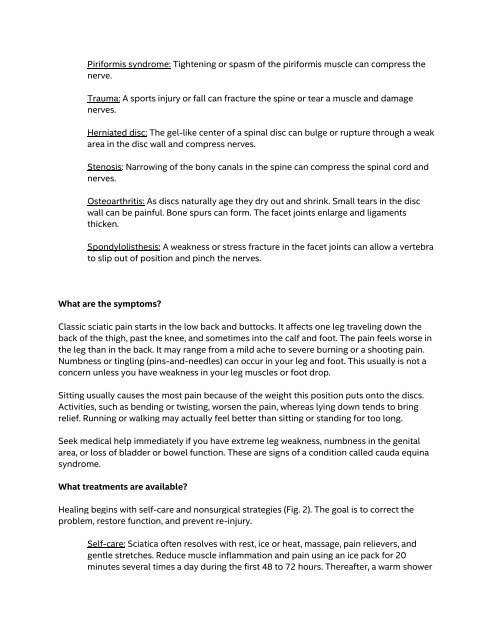You also want an ePaper? Increase the reach of your titles
YUMPU automatically turns print PDFs into web optimized ePapers that Google loves.
Piri<strong>for</strong>mis syndrome: Tightening or spasm of the piri<strong>for</strong>mis muscle can compress the<br />
nerve.<br />
Trauma: A sports injury or fall can fracture the spine or tear a muscle and damage<br />
nerves.<br />
Herniated disc: The gel-like center of a spinal disc can bulge or rupture through a weak<br />
area in the disc wall and compress nerves.<br />
Stenosis: Narrowing of the bony canals in the spine can compress the spinal cord and<br />
nerves.<br />
Osteoarthritis: As discs naturally age they dry out and shrink. Small tears in the disc<br />
wall can be painful. Bone spurs can <strong>for</strong>m. The facet joints enlarge and ligaments<br />
thicken.<br />
Spondylolisthesis: A weakness or stress fracture in the facet joints can allow a vertebra<br />
to slip out of position and pinch the nerves.<br />
What are the symptoms?<br />
Classic sciatic pain starts in the low back and buttocks. It affects one leg traveling down the<br />
back of the thigh, past the knee, and sometimes into the calf and foot. The pain feels worse in<br />
the leg than in the back. It may range from a mild ache to severe burning or a shooting pain.<br />
Numbness or tingling (pins-and-needles) can occur in your leg and foot. This usually is not a<br />
concern unless you have weakness in your leg muscles or foot drop.<br />
Sitting usually causes the most pain because of the weight this position puts onto the discs.<br />
Activities, such as bending or twisting, worsen the pain, whereas lying down tends to bring<br />
relief. Running or walking may actually feel better than sitting or standing <strong>for</strong> too long.<br />
Seek medical help immediately if you have extreme leg weakness, numbness in the genital<br />
area, or loss of bladder or bowel function. These are signs of a condition called cauda equina<br />
syndrome.<br />
What treatments are available?<br />
Healing begins with self-care and nonsurgical strategies (Fig. 2). The goal is to correct the<br />
problem, restore function, and prevent re-injury.<br />
Self-care: Sciatica often resolves with rest, ice or heat, massage, pain relievers, and<br />
gentle stretches. Reduce muscle inflammation and pain using an ice pack <strong>for</strong> 20<br />
minutes several times a day during the first 48 to 72 hours. Thereafter, a warm shower







